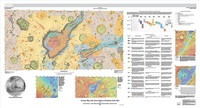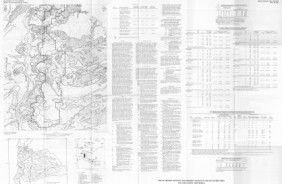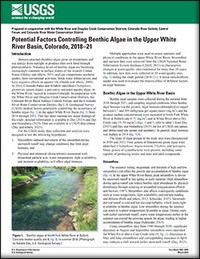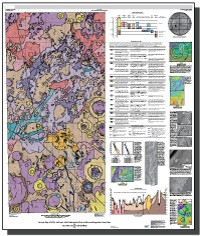
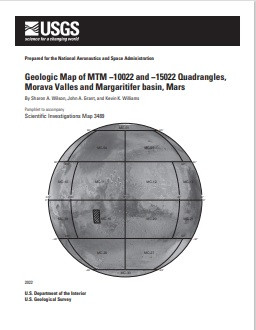
GEOLOGIC MAP MORAVA VALLES BASIN, MARS
Product Details
- Product Number
- 534128
- Series
- SIM-3489
- Scale
- 1:500,000
- Alternate ID
- SIM3489
- ISBN
- 978-1-4113-4478-5
- Authors
- JOHN A GRANT
- Version Date
- 01/01/2022
- Media
- Paper
- Format
- Folded
Additional Details
- Description
-
Geologic Map of MTM -10022 and -15022 Quadrangles, Morava Valles and Margaritifer Basin, Mars
First posted August 15, 2022
For additional information, contact: Contact Astrogeology Research Program staff Astrogeology Science Center U.S. Geological Survey 2255 N. Gemini Dr. Flagstaff, AZ 86001
Abstract
The landscape in Mars Transverse Mercator (MTM) -10022 and -15022 quadrangles (lat -7.5° N. to -17.5° N. between long 335° E. and 340° E.) in Margaritifer Terra preserves a record of sedimentary and alluvial deposits, volcanic and tectonic structures, and erosional landforms that record a long and complex geologic and geomorphic history. MTM -10022 and -15022 quadrangles primarily encompass Morava Valles, the terminus of the Samara-Himera and Paraná-Loire valley networks, the broad catchment informally named Margaritifer basin, and Margaritifer Chaos. Morava Valles is the lowermost reach of the northward draining mesoscale outflow system that consists of Uzboi Vallis, Ladon Valles, and Morava Valles, was sourced from flow out of Argyre basin, and incises across and between the ancient Ladon and Holden impact basins. The broad-scale topography and surface relief within the map, including the topographic low occupied by Margaritifer basin, were largely shaped during the Noachian by the formation of the Holden, Ladon, and Ares impact basins and the Chryse trough. Multiple processes modified the ancient surface until the Late Noachian and resulted in the formation of the terra unit that forms the widely exposed surface. Later resurfacing associated with likely sedimentary and volcanic processes modified predominantly lower elevation surfaces and basins during the Late Noachian into at least the Hesperian. Sedimentary processes during the Late Noachian were dominated by fluvial incision of the Samara-Himera and Paraná-Loire valley networks and discharge related to the dissection of Morava Valles that drained Ladon basin. The history of geomorphic activity within Margaritifer basin was more complex and was likely dominated by the evolution of Morava Valles relative to the formation of the valley networks. The floor of Margaritifer basin preserves likely lacustrine plains related to sedimentation in water ponded during early discharge from Morava Valles, which were later embayed by volcanic plains. Crater densities and cross-cutting relations indicate Margaritifer basin evolved over a relatively short period of geologic time. The timing of the last drainage out of Morava Valles is not well constrained but could have occurred during the Hesperian. Structural collapse and the formation of the Margaritifer Chaos and other chaotic terrain formed by the release of subsurface water that may have been related to volcanic activity along the southern margin of Margaritifer basin. Final geomorphic events within the map region include the formation of Late Hesperian to perhaps Amazonian alluvial fans within some craters and isolated mass wasting on steep slopes. A final, variable veneer associated with locally occurring impacts and redistribution of fine-grained material by eolian processes resulted in the landscape observed today.
- Height In Inches
- 54.010
- Length In Inches
- 45.730
- Two Sided
- No
- Pieces
- 1
- Languages
- English



